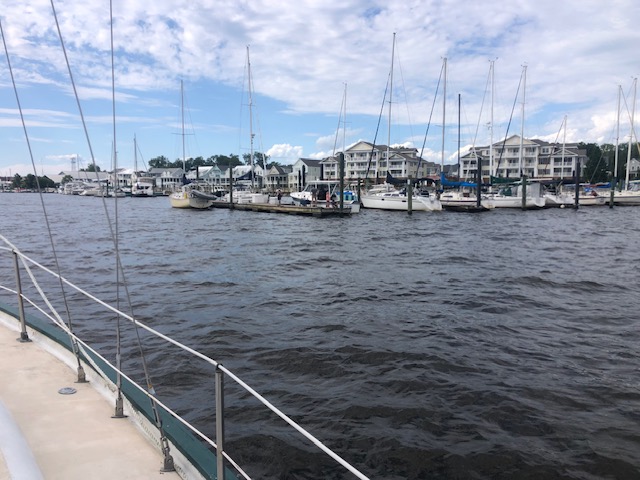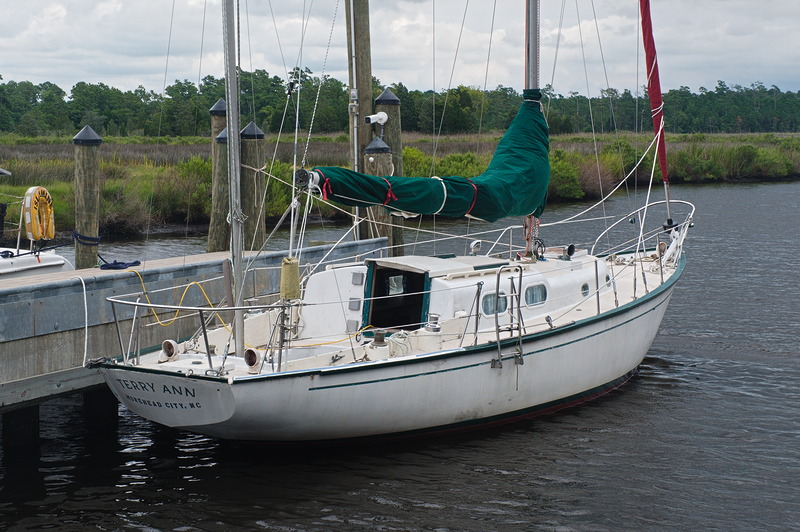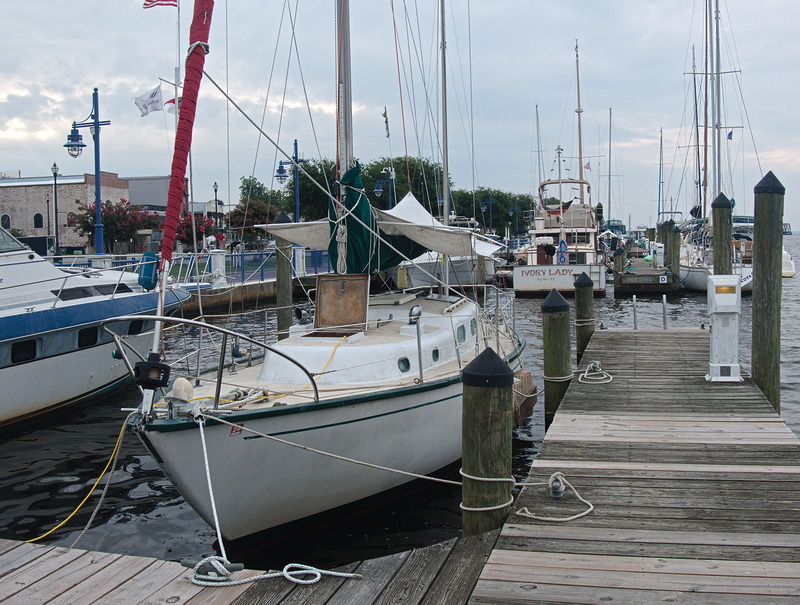Passage to Washington
Text by Paul Clayton, Photographs Paul Clayton and Taylor Ward.
Even a day sail can be a passage, if you end up on a different dock from the one you started on. Not that moving from Edenton Marina to the Edenton Town Dock really counts, but anything much longer does, in my book.
Gil Burroughs is the dean of Edenton sailors, one-time bluewater man and racer par excellance. All the local sailors turn to him for advice, and he patches and re-cuts sails for anyone who needs it done. He once encouraged me to put a traveller on the mizzen boom of my yawl Terry Ann, on the grounds that I could get a smidgen more speed with a perfectly shaped sail. I responded that, being more of the cruising than racing persuasion, there was absolutely no situation where I would take the time or effort to tune Terry Ann's mizzen. His reply was, if you're not getting the most out of your boat, what's the point of leaving the dock? I let it go at that, out of respect for the old man, but my response would have been, if you're just going to end up on the same dock you cast off lines from in the morning, what's the point of leaving?
A deep-drafted boat like Terry Ann can only get in and out of TJ's Boatyard on Battalina Creek at medium to high water. When we sailed Taylor's Hunter Never Enough in, we went firmly aground and had to call TowBoatUS to get us the last 50 yards to the dock. Later, we sailed Terry Ann in, and after an hour's work squirming and wriggling like a beached salmon, we got just onto the dock around the Travelift bay and were able to tie up for the night. By the morning, the water had come in, and we got the boat hauled. Our third experience with Battalina creek came when we took Taylor's boat back to Edenton in June of 2023. The water was high, we had explicit directions for finding the channel from yard manager Rob, and we motored out without incident.
A month later, I finished up work onTerry Ann, and the last Thursday in July the capable yard crew put her back in the water. My intent was to spend a day getting the boat in order and then sail to Little Washington on Saturday and put the boat on the City Dock. However, after a long spell of strong southerly winds, the water in Battalina Creek was low - very low. With these conditions, there was little chance that we would be able to get out the channel. There was nothing to it but to wait it out. The forecast called for the winds to shift to the north on Sunday, which meant that by Monday we might have some water. Fortunately, Taylor, my trusty crew, was flexible enough with his schedule to be able to sail Monday.
Finally the siege of southerly winds ended as a potent low pressure system passed to the southeast on Sunday, and the winds shifted to the north. The water ran back in to the creek and we made plans to move the boat on Monday. I met Taylor at the Washington dock at 8:00 in the morning, we dropped my truck, and took his Prius to Belhaven. By 9:30 we motored out of the Travelift bay where Terry Ann had spent the last two days and nights. Our sailing instructions were to proceed to the green marker directly ahead of the Travelift, turn hard aport and go to a half-submerged wreck, then back to starboard and leave the red marker close to port. Then it would be a straight shot out the midline of the creek to the river.
At the green marker we turned toward the wreck, made some progress and then ran aground. A few minutes of backing and filling and we came free. If the channel wasn't where I thought it was, maybe it was to port. We made a stab at it, but quickly grounded. This time it took a bit longer to get off, but eventually an inbound crabber came by and courteously cut his speed, but still gave us enough wake to bounce off the shoal. He also called over that the channel was more to starboard, and this time we were able to motor out without incident. The channel has moved a bit since we took Never Enough out, and is now more aligned with the markers - maybe due to the number of big trawlers and commercial fishermen transiting from the river to TJ's yard scouring out the more direct route. They have enough power to just plow through the shoals.
Out on the Pungo we found enough wind from the east to sail. Taylor took the tiller and I went forward, gathering in sail ties, to the mast. Then Taylor turned up into the wind and I raised the main. With freshly lubricated track and slugs, it went up easy. I came back to the cockpit and rolled out the jib. With Terry Ann's freshly painted bottom, she sailed easily on a beam reach, and we soon shut down the engine. The ten knot breeze pushed us down the river at over 5 knots - a good performance.
A power boat pulling an ancient wooden boat came by headed upriver, and a sailboat came out of Pungo Creek, also heading upriver. We got on the wrong side of marker 7 and had to make a short tack back into deeper water. The wind picked up and in the gusts various things - the stove, plates, the Toughbook chart plotter - crashed onto the cabin sole, no damage done. The wind clocked more toward the southeast, so we were now close-hauled. Once we turned out into the Pamlico River and worked our way toward the center, the wind was coming over the port quarter. It was a good ride for a few more minutes, but after we turned northeast to track up the river, the wind was essentially dead astern. The reduction in apparent wind speed and backwinding of the genoa took a big chunk out of our speed, so we decided to drop the main and motor-sail under the genoa. With Taylor at the helm and me working the sails, we made a smart job of rolling in the jib, dropping and corralling the main, and then getting the jib back out. We fired up the Beta and soon we were motorsailing up the river at over 6 knots.
 |
With the clear blue skies and reduced apparent wind, it started getting hot, so we rigged the small awning that I sewed for my old Cape Dory Valor over the cockpit. It was enough for one person to be in the shade, and as the sun came around to the west it shaded the tiller position. After that we took 1 hour tiller watches, and the person off watch could sit below in the shady, breezy cabin.
The navigation along the upper river was tricky enough to be interesting, really just a matter of picking out the next marker in the haze and making for it, but it was helpful to take a quick look at the plotter now and then. We hailed the dock as we passed the railroad bridge but didn't get a reply, then zigzagged past the stern of a big catamaran and into Terry Ann's slip on C Dock. Taylor jumped onto the dock with a bow line and had some trouble cleating it off, and I regret to say I yelled at him to hurry up and grab the stern line. It wasn't the prettiest docking but no harm done and Taylor shrugged off the abuse, probably used to it by now. With the boat secured we walked up to the office and signed in with the dockmaster, who gave us a recommendation for a restaurant close by. It turned out to be mediocre food with one overworked waitress trying to cover all the tables, but we did fill up on iced tea. From there we hopped in the truck and drove back to Belhaven where Taylor got his car and headed to Conway and I came back to Washington.
The next day at the dock, a passer-by hailed me and asked if the boat was an Alberg. That was the start of a pleasant conversation about sailing. He told me that when he was a kid his family of five cruised the Chesapeake aboard a Triton, a 27 foot Alberg design. He said the boat was tiller-steered, but his father eventually gave in to peer pressure and retrofitted a wheel. I told him no disrespect meant to his dad, but the only reason for wheel steering on a sailboat is to provide the fat rich bastard who owns the boat with a commanding place to stand. He laughed and said his father would have enjoyed that.
Text by Paul Clayton, photographs by Paul Clayton and Taylor Ward. Posted 08/07/23.
Copyright © 2023 Paul M. Clayton.


